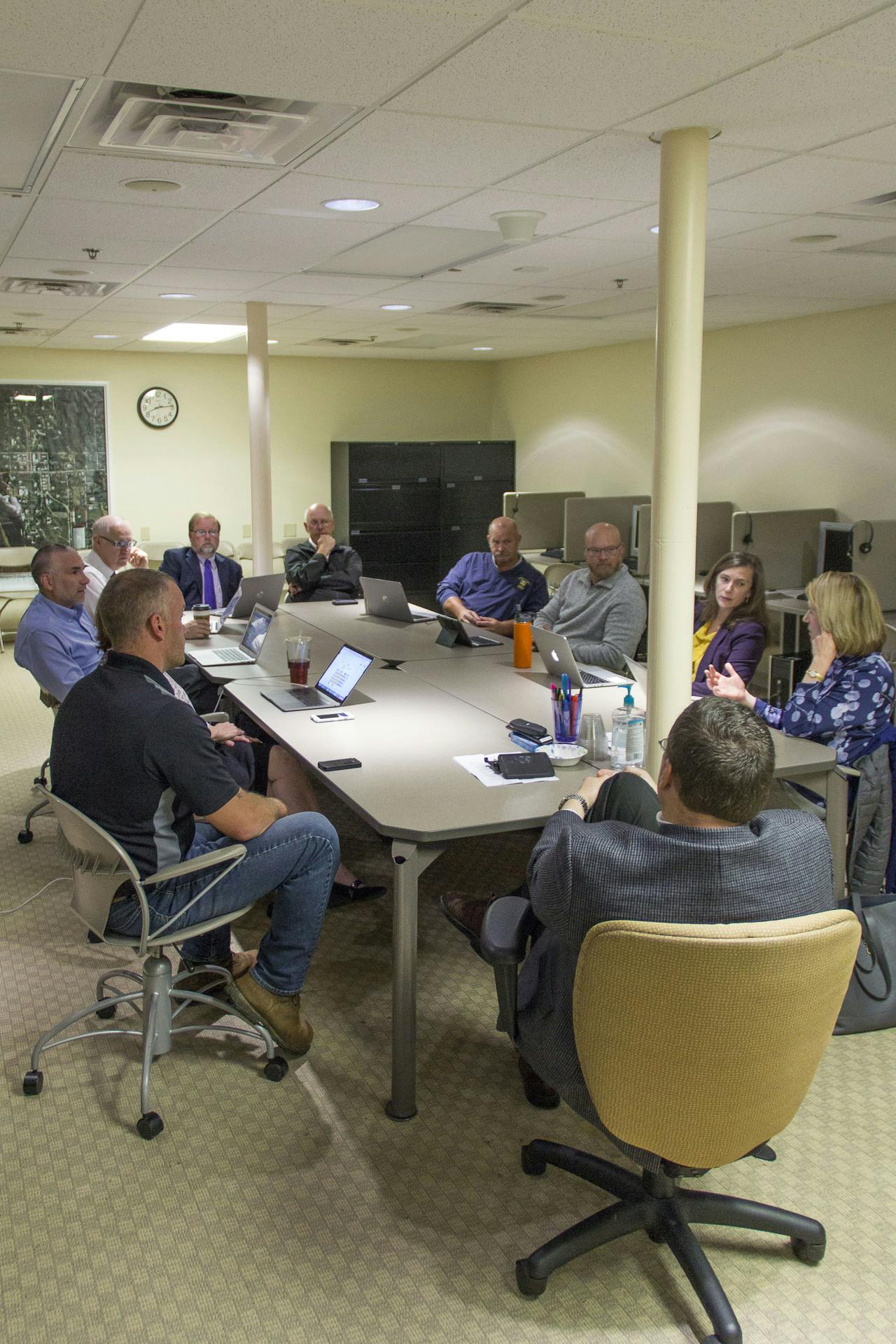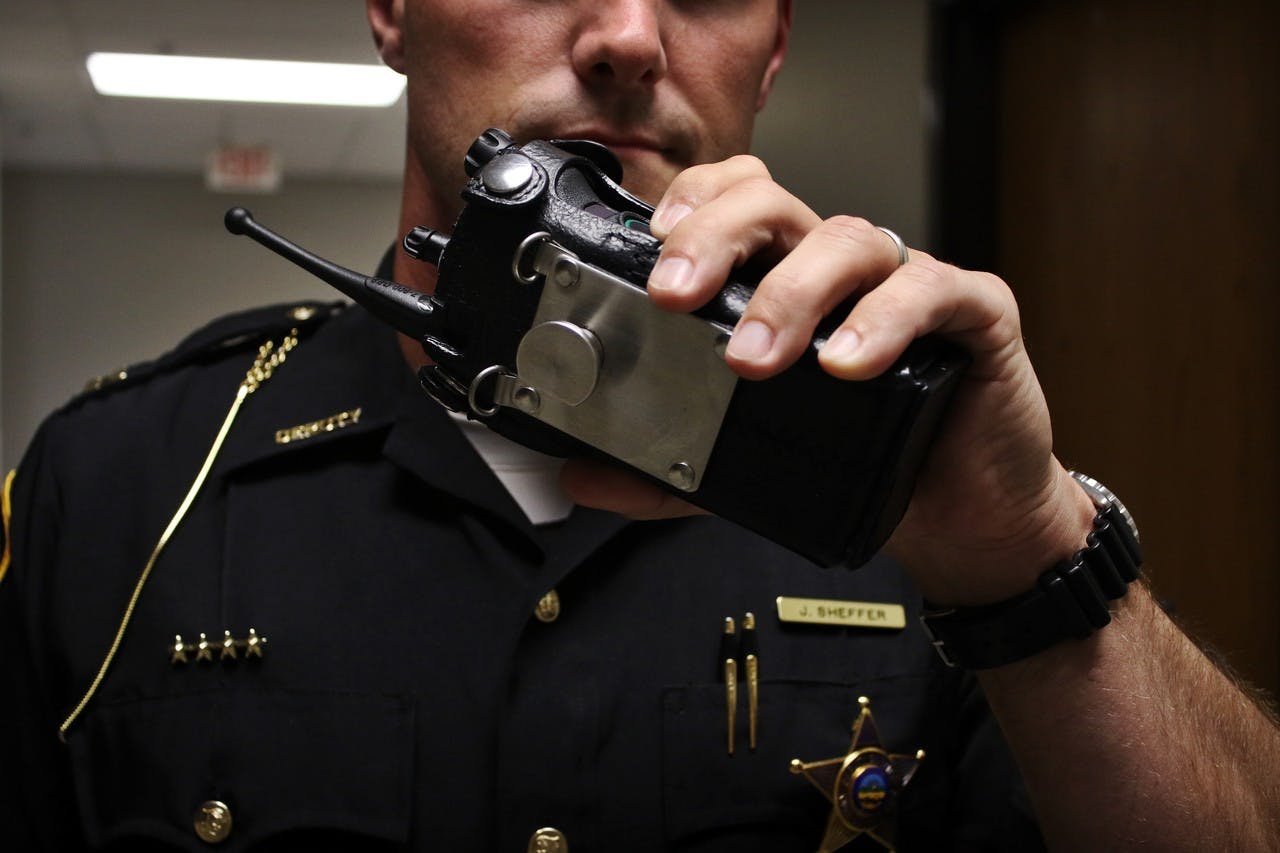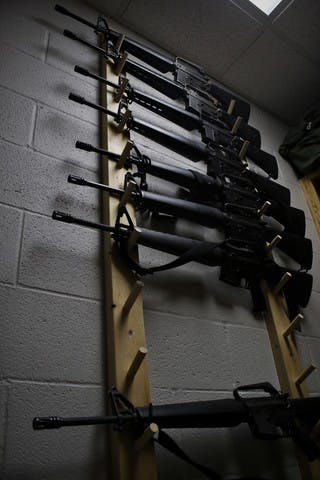Kenyon in the Crosshairs
11:00 a.m. A black SUV pulls up to the center of Wiggin Street and parks in the middle of the crosswalk. Kenyon students stop on their way to Peirce brunch, puzzled by the van. After a pause, a man in a flannel shirt and jeans opens the driver door and walks towards the trunk.
Without saying a word, the man pulls out an AR-15 rifle and takes aim at the cluster of students. The sound of the first shots can be heard from the post office to Gund Gallery. Kenyon is under attack.
While there hasn’t ever been an active shooter event at Kenyon, the administration and the Office of Campus Safety prepare Kenyon for the worst. According to CNN, which defines an active shooter event as an attack that kills four or more people where victims are selected randomly and attacked in a public place, there have been nine mass shootings between Jan. 1 and Oct. 3 this year. The last 10 years have seen four of the five deadliest shootings in American history; the attack in Las Vegas on Oct. 2 was the deadliest. With the world changing, Kenyon has adapted to today’s growing safety demands. Over the past two years, Kenyon has trained the entire faculty and staff, the Community Advisors, and this year’s freshmen class in active shooter readiness, implemented a communications system able to reach every student within seconds, and modernized our emergency management structure to be in line with the national standard. But will all of our training and preparation stop an active shooter?
“I really like to use the term active killer because I think that better describes their mindset,” Director of Emergency Services for Knox County Mark Maxwell told the Magazine. “They have to do as much violence as quickly as they can, because they know law enforcement’s coming; they have a limited time frame to do that.”
Maxwell was recently brought to campus to give an active shooter preparedness presentation to the freshmen. The program, developed by the Knox County Sheriff ’s office, takes students through “run, hide, fight” training to ensure that every student knows what to do in the event of a school shooting. “It’s really about individual preparedness in my mind,” Maxwell explained.
Last semester, Maxwell, along with Campus Safety and Jay Sheffer, a captain in the Knox County Sheriff ’s office, taught the same program to campus faculty and the administration with the intention of eventually training the entire campus.
Sheffer teaches that to effectively run from a shooter, students should be aware of every conceivable exit and entrance in a building. Once they are outside, he instructs students to head for the woods while running in zig zags. If running isn’t an option, Sheffer wants students to shelter in place and use anything available to barricade all entrances.
If running and hiding are impossible, Sheffer teaches students to fight a shooter, but only as the last resort. If fighting is the only option available, Sheffer wants students to fight effectively.
“They’re coming in expecting us to not do anything to them. Be their little herd of sheep that’s not gonna fight back. We want to teach everybody to become that sheepdog, to fight back and give yourself and others a chance to survive that situation.”
While the training is important, freshmen who went through the program don’t feel prepared for an event. Many said the entire presentation was uninformative and left them feeling lost and that their time was wasted.
“It was the worst presentation that didn’t give us any actual skills,” Jess Karen ’21 said. “It wasn’t tips on how to survive it, it wasn’t training, even though that’s what the title of the PowerPoint was. It was like: These are the shootings that have happened at different schools, here are the numbers of how many people died.”
While the training of the freshmen is a first step, Kenyon clearly has a long way to go before the student body feels adequately prepared.
Sheffer and Maxwell came to to Kenyon at the request of the Kenyon Emergency Preparedness Team (KEPT). KEPT is the brain of Kenyon’s emergency response. They meet every other week to discuss new training efforts, brainstorm safety improvements, and develop emergency structures for possible campus-wide disasters. KEPT consists of senior staff officials, including Vice President of Student Affairs Meredith Bonham, Chief of Staff Susan Morse, Director of Emergency Services Todd Bell, and others.

When not in the Village, it can take officers up to twenty minutes to respond to an emergency.
11:01 a.m. As the shots echo across Middle Path, Campus Safety mobilizes. Director of Campus Safety Bob Hooper calls emergency responders: “We have an active shooter at Kenyon, send everyone.” At the same time, Todd Bell sends a RAVE alert to all students notifying them of the situation: There’s an active shooter at the Gates of Hell. Shelter in place. Law enforcement is on the way.
Hooper walked the Magazine through Campus Safety’s role in an active shooter situation. First, he would call first responders to get them to campus as fast as possible. Once they are en route, he would then send a RAVE alert notifying campus of the situation, including details of the shooter’s location, outfit, and weaponry. Campus Safety would continuously update campus on the shooter’s location as it changes.
The RAVE messaging system was one of the main improvements KEPT made to prepare Kenyon for emergencies. In the event of an emergency, administrative officials send up-to-date information via text and email to every student, in addition to an automated call through the RAVE system. Today, RAVE is able to reach 90% of campus in seconds.
The need for increased emergency communication on college campuses spiked after 2007, when a gunman at Virginia Tech killed 32 people in three hours in what was the second deadliest school shooting event in American history. That day changed how campuses across the country approached the reality of a gunman on campus.
“Virginia Tech was criticized in large part because their communications systems were not as sophisticated as they needed them to be in order to message immediately to students that this was occurring,” Bonham said regarding the 2007 shooting. Bonham feels much more confident today about Kenyon’s communication abilities than she did when she arrived. However, with an instantaneous messaging system at their disposal, KEPT and Campus Safety need to make sure their information is correct and up-to-date before they alert campus.
During Bonham’s time as Senior Associate Dean of Students for Hamilton College, a student called Campus Safety and claimed they saw someone walking into the woods with an assault rifle. An emergency response message was sent out that threw the college into a panic. When the police arrived, they found the individual. The assumed assault rifle turned out to be an expensive camera.
Because of this, Bonham recognizes that an emergency message must be sent out with as much up-to-date information as possible. “We might get a call saying, ‘I just saw someone with a gun walking across campus,’ but if we don’t know where that individual is, maybe it’s not a gun… We have to sometimes get a little more information before we actually get an emergency message out.”
to get ready or provide supplies or movement of students to an interior rally point.”
Having Kenyon on the ICS system helps coordinate emergencies between a private institution like Kenyon and the county at large. In the event of an emergency, the ICS system streamlines communication between local assistance, such as Maxwell, and Campus Safety. The structure consists of an incident commander who takes charge of the situation and liaisons to Ohio emergency services, which include the fire department, Red Cross, and Knox County emergency medical assistance.
“One of the great principles of that is we can all talk because we are all using the same language,” Maxwell said.

The KEPT team meets at an undisclosed location.
11:03 a.m. Maxwell receives the call that there is an ongoing event at Kenyon. He puts the phone down and takes a moment to gather his thoughts. “Prepare the Emergency Operations Center,” Maxwell commands, getting up from his chair. He has to move fast.
Whenever there’s an emergency situation in Knox County, Maxwell prepares the Emergency Operations Center (EOC). The EOC is responsible for coordinating with the ICS commander to get them the resources they need, whether it be ambulances, fire trucks, medical helicopters, law enforcement, or anything that the situation calls for.
In addition to supporting the incident commander with necessary resources, the EOC helps with recovery after the event by supporting the healing of the county. Maxwell’s department also controls the messaging for the surrounding area and monitors social media.

Captain Jay Sheffer instructs the county in "run, hide, fight" training.
11:10 a.m. The nearest deputy arrives on the scene. Drawing his weapon, he races toward the gunfire. Other road units are still minutes away.
In an active shooter event, the first responder on the scene is the assigned deputy from the sheriff ’s department. In total, two deputies are assigned to Gambier. These officers carry a weapon and are trained to engage the shooter.
Although there are deputies assigned to protect the Village, the system is far from perfect. “There’s lots of holes,” Campus Safety Supervisor Greg VonFreymann said. “One guy works Wednesday through Sunday, but he’s off Monday and Tuesday nights. So Monday and Tuesday nights, there’s nobody here.”
In addition to the holes in the schedule, a deputy in or around the village would take two to three minutes to arrive on the scene. Without a nearby deputy, the response time increases to around 20 minutes. For context, the 2012 shooting at Sandy Hook Elementary in Newtown, Conn. was over in six minutes, with 20 children and six teachers killed.
“If our deputy is standing on the street in front of this building and the bad guy comes in here, even if the deputy is that close, it’s not going to help us,” Maxwell warned. “That’s why the run, hide, fight training is so important, so that people understand how to deal with those types of situations. It’s always great that law enforcement is closer, but if your plan is, ‘I’m just going to wait here for law enforcement to get here,’ then you’ve set yourself up for failure. Unless they’re sitting in the room with you, they’re not going to help in these types of situations.”
11:15 a.m. Law enforcement arrives on the scene. Officers from Danville, Fredericktown, Mount Vernon, Holmes County, Ashland County, and state patrol all arrive to stop the shooter with lethal force. Meanwhile, Campus Safety officers maintains their distant perimeter. They cannot get close to the situation, as they’d only become further casualties.
“The sad part is, and I don’t think students realize, that if there’s an active shooter situation I’m not responding to that,” VonFreymann said. “The officers are not responding to that because we don’t have vests on all of the time, and we also don’t carry a firearm. … I’m not going to send officers out in campus, ’cause they’re just going to get shot.” Nearly a decade ago, there was a triple homicide at a house by the KAC. In response, Campus Safety was given bulletproof vests to better equip themselves for modern threats. However, the vests are kept in the vehicles and the office and, if they aren’t close, officers won’t have them in an immediate crisis.
Presently, Campus Safety can only set up a far perimeter in an active shooter event. But with a response time of one minute, VonFreymann and other officers would be in favor of shoring up what he sees as a security issue.
Sheffer agrees that setting up a perimeter doesn’t have a real impact. “With Columbine, what they did was set up a perimeter to make sure we contain the bad guys, but during that time they’re losing kids, staff, and teachers because they’re not going in. They were waiting for SWAT to come in.”
VonFreymann knows that officers can only stop a shooter if they are properly equipped. “You’re not stopping anybody with a gun unless you have a gun, it’s just not happening. I would like to see more law enforcement, 24 hours a day. That would be a better equation.” By his estimate, three to four more deputies would need to be hired to adequately protect Kenyon. However, adding deputies to the Village would require approval from the Village Council and the mayor.
If the sheriff ’s department isn’t able to provide more deputies, VonFreymann would like to see armed security assigned to the Village, though he realizes that this is unlikely due to Kenyon’s financial restrictions.
“The institution and the community don’t want to pay for low probability. What is a life worth, is what it comes down to. Is it worth that extra 100,000 dollars a year?”
Bonham believes that a separate security force would be an unwelcome addition to Kenyon’s atmosphere and would fundamentally change the culture on campus. It’s not a decision she would enter into lightly.
With money as a constraint, VonFreymann would like Campus Safety to be adequately equipped to deal with a shooter. “I have no problem going into Peirce in an active shooter situation if I have a vest and a gun. I’m not going to go running into Peirce and throw my radio or keys at him. A lot of people are against weapons, but they’re a tool just like anything else.”
A veteran of two tours in Iraq and six years in the U.S. Air Force, VonFreymann is no stranger to guns. If Campus Safety were to be armed, he would like to hire and equip individuals who are accustomed to handling firearms. Currently Campus Safety has officers with law enforcement backgrounds and military backgrounds. At least four or five officers have concealed carry permits in Ohio, including VonFreymann and Hooper.
Bell is skeptical that arming the department is the right decision but won’t rule out the possibility. “I’m not going to say yes or no. There would be a lot of research that would have to be done before we could get to that point.”
According to VonFreymann, arming Campus Safety would be a slow process, beginning with a 40-hour mandatory armed security course. Initially, only the director would be armed, followed by the supervisors. Then they would pick and choose which officers would even be comfortable carrying a weapon.
When it comes to decisions of this magnitude, Hooper understands that all parties, including the student body, would have to be consulted.

Knox County Sheriff Armory
11:20 a.m. Law enforcement brings down the gunman. Bell sends a RAVE alert notifying campus that the situation has been resolved. Bonham begins planning Kenyon’s recovery process and call for the KEPT board to convene. Sheffer and Maxwell begin drafting a statement for the media about the situation.
This is how Kenyon would respond in a real active shooter event. After overhauling Kenyon’s communication system and bringing Kenyon’s organizational structure in line with that of the county, KEPT and Campus Safety are continually improving Kenyon’s emergency response measures to protect campus from all modern threats.
With the recent string of terrorist attacks, Hooper isn’t ruling out any possibility. “The world’s changed. We’re in a very different place now. You see these acts now that are in churches on a Sunday morning. It’s a very different place.”
For the future, Bonham is planning to run a live active shooter drill that would encompass campus, the sheriff ’s office, and emergency services. The practical would include real-time developments and actors armed with airsoft guns. She believes that this is the next logical step in Kenyon’s training.
When it comes to educating students and training officials, Von Freymann knows that preparation can’t be done only once — it has to be a continuous effort, as the world isn’t getting any safer. “[Active Shooter events] haven’t slowed down since Columbine; it’s only gotten worse.”
Kenyon can’t foresee everything, and Bonham is fully aware of that reality, but she’s optimistic about the progress that’s happened in the last two years. “Any of us could be walking down Middle Path and someone could take out a gun. I could be sitting in my office, and someone walking by could shoot through the window. I don’t think we can possibly foresee every potential opportunity for violence on campus, but we try and minimize those when we can. I think that’s why the training and education is so critical. Nobody knew that someone was going to put bombs in their shoes and walk onto an airplane with them; nobody anticipated that. We don’t know what some person might decide to do in order to wreak havoc and cause violence on our campus. But what we can do is train and educate people so that they have some sense of their own ability to protect themselves and other members within the community.”
